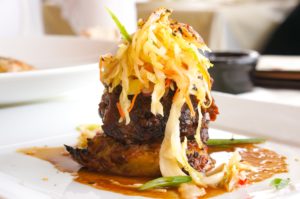 Asia is a good place to put one’s stomach to the test. However, the rest of the world also has a lot of specialties out of the ordinary.
Asia is a good place to put one’s stomach to the test. However, the rest of the world also has a lot of specialties out of the ordinary.
The culinary aspect is very important during a trip. We discover a country with our five senses, and the taste is an important aspect not to forget.
I have no problem trying new things, but the texture of the food may be my weakest point. I had the chance to try the alligator in Louisiana, the pigeon in Egypt, the guinea pig in Peru, the llama in Bolivia and durian in Montreal.
As for the Asian list of the most bizarre dishes made previously on this blog, some dishes on this list leave me a little puzzled. It is up to you to see if any of these local specialties inspires you.
Here are the 10 most bizarre non-Asian specialties I have found:
-
Akutaq – Alaska
Akutaq is a dessert that is made of whipped fat with berries, fish, and sugar.
-
Witchetty Grubs – Australia
Witchetty grubs are the wood-eating larvae of the moths. Most of the time eaten alive and raw (sweet almond taste with a liquid center), but they can also be found barbecued (chicken peanut taste) or in soup.
-
Grilled Grasshoppers – Africa
What more to say! Perhaps we should add a little sauce to enhance the taste?
-
Haggis – Scotland
The haggis is a traditional dish prepared with mutton or sheep offal (heart, liver, lungs) minced and mixed with onions and oats. Afterwards, they are seasoned with salt and spices before being cooked in the animal’s stomach for about three hours.
-
Muktuk – Greenland
Muktuk is a mixture of skin and whale fat that can be eaten raw or fried. It is considered a delicacy by locals. This dish has a fat and chewy texture and is a good source of vitamin C and D.
-
Hakarl – Iceland
The hákarl is fermented shark meat put in a hole, covered with sand and stone between 6 and 12 weeks. Then, the meat has to be dried for several months, suspended from the ceiling. This dish has an intense smell that is not bearable by all.
-
Casu Marzu – Italy (Sardegna)
Cheese from sheep’s milk to which small insect larvae are added. This technique aims to bring the wheel to an optimal degree of fermentation and break down the fat cells. A cheese can contain thousands of larvae. Some people remove the larvae before eating it, but it is not mandatory.
-
Zimne Nogi – Poland
Zimne Nogi takes several hours to prepare. It is composed of boiled cow’s foot with several spices. Then, they are placed in the refrigerator until you see a layer of fat and a gray translucent jelly.
-
Blodpättar – Sweden
Blodpättar is a fried pork blood pancake.
-
Surstromming – Sweden
Surströmming is herring that is fermented for at least six months.
So, which specialty do you want to start with?